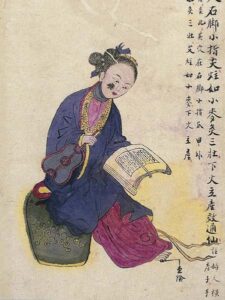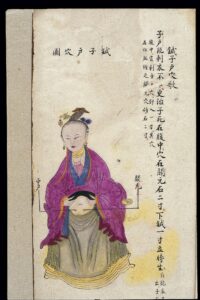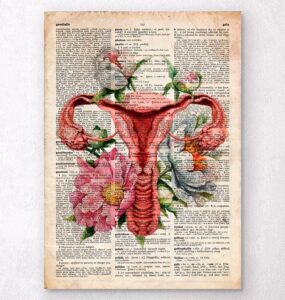An exploration into Fibromyalgia & Acupuncture
~ scroll to the end for ideas about what you can do, right now!
Once understood in modern science as a psychological disorder or ‘nervous exhaustion’ and first called fibrositis in 1904 by Gowers. In 1972 fibromyalgia was termed in cases of widespread pain and particular tender points1. To this day tender points are assessed (pictured below) along with the individual’s self-reported concerns to arrive at diagnosis.

Curiously these points correspond to traditional Acupuncture points! However, measurements of Acu-points are unique to your body’s proportions, known as ‘cun’ (pronounced tss-un), of which one is the width of your thumb. Some of the points pictured are also my go-to in practice.
There are disorders that present similar to fibromyalgia, it is important to consult a professional and explore the necessary diagnostic tests to arrive at the correct diagnosis. The list pictured below is not exhaustive, it points at a complex web of differential diagnosis and why receiving professional help is so important.
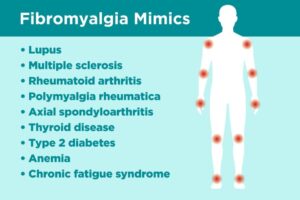
Fibromyalgia is generally defined as a chronic state characterized by widespread pain, fatigue, muscle stiffness and insomnia. Important to note that this disorder is not simply about pain, it is about sensitivity and heightened response to painful stimuli; which is why all types of painkillers are not recommended. This subtlety can be frustrating and does not invalidate your lived experience. Fibromyalgia along with autoimmune conditions disproportionally shows up in those of the female sex. Please note that the jury is still out as to if fibromyalgia is an autoimmune condition.
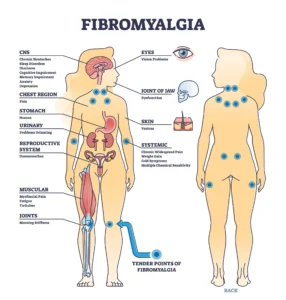
https://www.morningsideacupuncturenyc.com/blog/what-is-fibromyalgia
From a Traditional Chinese Medicine perspective; Fibromyalgia would generally be explained as a type of stagnation leading to stasis, causing pain and internal agitation. The classics state: ‘where there is pain there is blockage.’ Disorders that arise internally, as in not from a physical injury, parasites, environmental exposure or toxins, are said to originate of repressed or internalized emotions. While there are theories that environmental toxins may precipitate fibromyalgia, severe stress or trauma are well documented in case studies. Rare is the story of textbook origin. Interesting to note that it seems fibromyalgia was known, documented and treated by TCM. In the classics, when the Zu Tai Yin (so-called, Spleen Meridian), was weakened there would be digestive issues like diarrhea and poor digestion, fatigue, weakness in the muscles and limbs, poor memory and insomnia. This aspect of being and specifically the areas on the lateral side of the ribcage, below the underarm were found empirical points to address pain of the whole body, weariness of the four limbs, flaccidity of the limbs and flaccidity of the hundred joints2. In most cases of fibromyalgia, from a TCM perspective, is a weakening of this region from the excessive strain of stress and problem solving. Imagine a root-bound plant, it is struggling to survive and literally oppressed so not open to imagination. This is a metaphor for the aforementioned pattern involving dissonant internal processes. If you are feeling like a root-bound plant, there are options for you and support available.
Traditional Chinese Medicine shines in the balancing of confusing, nebulous and frustrating experiences common in chronic conditions. Acupuncture works specifically in cases of fibromyalgia by unblocking stagnation to give relief of pain. As well by returning your physiology to homeostatic connection which will foster a sense of calm, improved sleep and boost both mood and energy3. While some benefits will be immediate, it may take a month or more, so consistency will be important. Chinese herbalism is beneficial in tandem with regular Acupuncture visits.
What you can do, right now!
- Rest: sleep is only one form! Incorporate the ‘seven forms of rest’. Turn off artificial light at least an hour to two before bed. Aim for sleep earlier (by nine pm, if possible).
- Move: Regular & low impact. Walk 10,000 steps a day or do 100 squats. Try Yoga, Qi Gong, Tai Chi, Pilates and swimming. Low intensity is better, preferably with weights.
- Nourish: Aim for stews and soups with all the colours of the rainbow. Meat, offal and gelatin are important. Tisanes like tulsi, camomile, rose and lavender can aid relaxation. Consult a professional and give Traditional Chinese Medicine Herbalism a try!
- Balance: Listen to your body. Commit to consistency instead of intensity.
Art: Petr Pavlensky https://www.artriot.art/artist.html?id=PyotrPavlensky&ch=perfomance&tid=40

